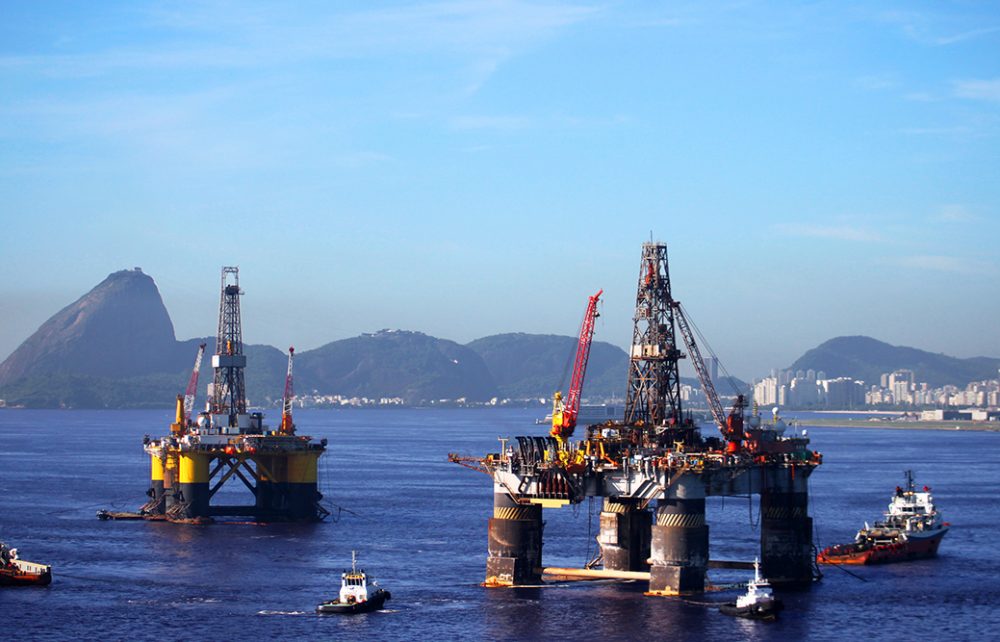Brazil’s oil industry has had very mixed fortunes in recent months. Production is higher than ever but the latest oil licensing round attracted very little interest from the foreign firms, suggesting that the boom may be short-lived, unless either the government improves the investment regime or international oil prices rise substantially.
The fact that 14 oil companies had registered to submit bids for acreage in Brazil’s latest licensing round had raised hopes that the blocks on offer would be licensed. Yet aside from Petrobras, China National Offshore Oil Corporation (CNOOC) and China National Oil and Gas Exploration and Development Company (CNODC), which is an offshoot of China National Petroleum Corporation, were the only successful bidders in the round and they took small stakes of just 5% each in the licence that contains the huge Buzios field.
Petronas retains 90% interest in Buzios, which already produces about 443,000 b/d. Petrobras also secured another, smaller block, Itapu, on its own but no bids were submitted for two of the four blocks on offer. The immediate market response to the lack of interest was a fall in the value of the Brazilian currency, the real.
The four blocks on offer, which hold an estimated 15 billion barrels of oil, were open to bids following an agreement between Petrobras and the government over their fate. The four had been controlled by Petrobras but the government had challenged the company’s view over how the revenues should be distributed. However, the two sides reached agreement in September, with some or all equity on each block offered to foreign investors in return for Petrobras receiving US$9 billion in compensation.
There is undoubtedly a link between the lack of interest and the high cost of deepwater operations but more attractive investment terms would surely encourage bids from investors eager to tie up more deepwater acreage in preparation for a recovery in international prices. It had seemed as if oil prices were set for a steady rise in the early part of 2019, as the price of Brent crude reached US$74/barrel in April but the trend has been largely downhill since then, reaching US$64/barrel by 10 January 2020. Prices surged after the killing of Iranian military commander Qassem Soleimani in Iraq in early January raised fears of a broader Middle Eastern war but short of such a conflict, international oil prices look unlikely to rebound substantially this year.
Nevertheless, Brasilia is currently considering the introduction of a new fuel price regulation mechanism. Energy minister Bento Albuquerque said that the government could use some of the revenue it generates from oil royalties to subsidise fuel costs. “We are looking at the royalties, those things that we as oil exporters see as possibilities to accumulate reserves that could compensate for unexpected increases in oil prices. We should be prepared for the future, so Brazil would not suffer from some international crisis,” he said.
Rising deepwater output
The lack of interest is certainly not a reflection of a lack of potential in Brazil’s offshore prospects. Petrobras, which aims to focus on oil and gas production rather than midstream and downstream operations, produced a record 3.1 million barrels of oil equivalent a day (boe/day) in November and an average of 2.7 million boe/day over 2019 as a whole. The company expects production to stabilise at 2.7 million boe/day for the first half of 2020. Boe includes natural gas, natural gas liquids and condensate as well as crude oil. According to the national petroleum agency, total Brazilian oil and gas production reached 3.95 million boe/day in November, with production rising 20% over the course of the year.
The pre-salt fields that have driven oil industry growth accounted for 2.06 million b/d in November, including a massive 1.06 million b/d alone from the Lula field, which came on stream in 2010. Oil production has risen on the back of new deepwater projects, with eight new floating production, storage and offloading vessels (FPSOs) coming on stream over the past year. The most recent FPSO to be launched, FPSO P-68, was installed in early November on the Berbigao field in early November with the capacity to handle 150,000 b/d and 6 million cubic metres/day. Opec’s most recent World Oil Outlook stated that Brazil has the biggest long term oil potential of any non-Opec country.
Natural gas production also reached a record high in November, at 136.6 million cubic metres/day, up from 112.4 million cubic metres/day in the same month in 2018. However, about a third of all gas production is reinjected into reservoirs, partly in order to support oil production but also because of the lack of infrastructure to find a commercial outlet for it. The Brazilian oil and gas industry has traditionally been taken to mean ‘oil’, with some gas imported from neighbouring Bolivia. Yet if production continues to rise then the government may have to take domestic gas production more seriously.
Recent research by consultants Rystad Energy says that many of the offshore oil projects sanctioned before 2014 generated little or no profit for investors because of higher than anticipated engineering costs. The world’s main hydrocarbon basins, including Brazil’s Campos Basin, have helped drive growth in global oil production since the turn of the millennium but costs are substantially higher here than onshore or in shallow water.
Beijing wants deepwater experience
However, China’s biggest oil companies are keen to acquire deepwater experience around the world that they can put into practice at home. China’s most advanced deepwater drillship, the Ocean Oil 982, was deployed in the South China Sea in September. CNOOC has drilled more than 50 exploration and appraisal wells in the South China Sea since 2010 but has mainly discovered natural gas rather than oil.
CNOOC and CNODC are already active in Brazil, with each holding a 10% stake in the Mero field, operated by Petrobras with a 40% share, with the remaining equity owned by Shell Brasil Petroleo (20%) and Total E&P do Brasil (20%). The field is located about 180km offshore, in 2,000m of water and 5,000m under the seabed. The first FPSO deployed on Mero, which came on stream in November 2017, has production capacity of 50,000 b/d.
In December the consortium signed a deal for a new FPSO to be operated on the field by NYK and Mitsubishi Corporation from 2022. FPSOs are used in deepwater areas where it would not be feasible to use a fixed platform. This vessel, the Sepetiba, will have production capacity of 180,000 b/d, plus 12 million cubic metres of natural gas a day. Two more phases are planned on Mero.
Most FPSOs, floating liquefied natural gas vessels – which are used to turn natural gas into liquefied gas – and floating storage and regasification units – which are used to reverse the process – are manufactured in South Korea and Japan but Beijing is keen to see Chinese shipyards, including China State Shipbuilding Company, become more active in the sector. This fits in with the government’s strategy of promoting high quality, skilled manufacturing at the expense of mass market manufacturing.
CNPC had been expected to invest in completing the half-developed new refinery complex at Comperj in the state of Rio de Janeiro alongside partner Petrobras as part of an agreement signed between the two companies in 2018, but the plan appears to have been abandoned.
Roberto Castello Branco, who was appointed Petrobras chief executive in January 2020, told journalists in December that the project feasibility study “showed that it wasn’t economically feasible … CNPC didn’t have much interest in this project”. The scheme became caught up in the wide ranging Lava Jato corruption scandal, with allegations made about how contracts on the project had been awarded. Castello Branco described Comperj as “a cemetery of corruption”.
It is interesting that he pointedly mentioned CNPC’s position on the project but in any case Petrobras is divesting some of its non-core operations, including its existing refining capacity. Developing a more modern refinery could have made economic sense in the long term but Petrobras is selling assets to try to pay down its debts. The firm is now considering its options for the half-built complex, including producing lubricant and integrating the units that have been completed at the site with the Duque de Caxias refinery.
Petrobras finances
The sales helped cut the Brazilian firm’s US$100 billion debt by US$21 billion in the first nine months of 2019 and it hopes to erode it further to US$60 billion by 2021. The company now aims to raise US$35 billion from asset sales over the period 2018-23, including some thermal power plants, up from its previous target of US$27 billion. In particular, it plans to sell its 51% stake in gas distribution company Gaspetro, in the first instance through an initial public offering (IPO), leaving Japanese Mitsui with 49%.
That project aside, Petrobras’ finances have improved to such an extent that in December the company was able to pay off the remainder of its US$5 billion loan to China Development Bank, which was signed in 2016, eight years ahead of schedule. It was partly servicing the debt through providing Chinese companies with preferential oil prices, but that deal is now also expected to come to an end. It has been suggested in Brazil that President Jair Bolsonaro will seek to privatise the company by the end of his current term of office.




